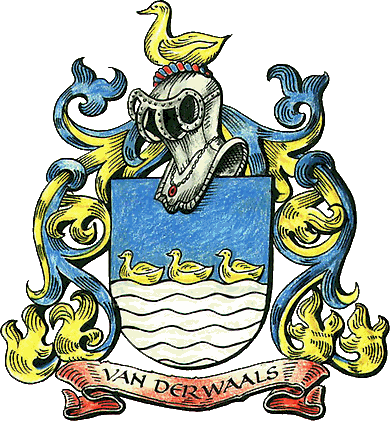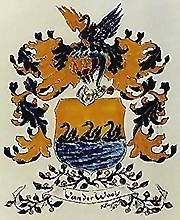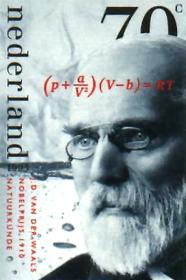Per fess wavy Or and Azure,
three swans Sable naiant in fess overall.
Crest : A swan Sable.
Mantling : Sable and Or.
Johannes
Diderik van der Waals was born in Leyden
(Netherlands) on November 23, 1837 and became a schoolteacher without
ever acquiring any knowledge of the classical languages.
This meant he could not sit for formal university examinations at Leyden.
He could merely attend classes in his spare time (from 1862 to 1865)
and obtain teaching certificates in mathematics and physics.
When the classical languages requirements were finally lifted for students in Science,
van der Waals could move on with an academic career and obtain a doctorate
in 1873 (he was 36 years of age by then)
His doctoral dissertation was entitled
Over de Continuïteit van den Gas en Vloeistoftoestand
(On the Continuity of the Gas and Liquid State).
It was so remarkable that the great
James Clerk Maxwell himself
gave it one of the highest compliments ever paid by
one scientist speaking about the work of another:
"It has certainly directed the attention of more than one inquirer to the study
of the [Dutch] language in which it is written."
In that masterpiece of his, van der Waals
introduced the famous
equation of state,
now named after him, which relates the pressure, volume and absolute temperature
(p, V, T) of a mole of some fluid:
( p + a / V2 ) ( V-b ) = RT
In this, a, b and R are
constant for a given fluid.
For an ideal gas, a and b
would be zero and the above would reduce to the
Ideal Gas Law
for one mole (n = 1) of a "perfect" gas.
However, for a "true" van der Waals fluid
(for which a and b are nonzero)
the constant R need not be equal to the perfect gas constant
(of 8.31447 J/K).
It's just another parameter which can be adjusted for a best fit of the
van der Waals equation of state to actual measurements
of a real fluid. In spite of what a few
misguided
comments may state, the
van der Waals equation of state does feature
three adjustable parameters (a, b and R).
In fact, the three parameters of a perfect
van der Waals fluid are best expressed in terms of the values of
p, V and T at its
critical point
(the "critical state" of a fluid was first chracterized by
Cagniard in 1822).
a = 3 pV 2
b = V / 3
R = 8 pV / 3T
The parameter b (called molar covolume)
is the nonzero volume that the fluid would occupy
under a very large pressure. Van der Waals argued that atoms and molecules had
finite size
(see Van der Waals radius)
and that external pressure could not reduce the volume occupied
by bouncing molecules when there are already almost "touching" each other.
The positive term a / V 2
is called inner pressure or internal pressure
and corresponds to an attraction between molecules.
(Technically, that inner pressure
is always defined as the isothermal derivative of the internal energy
U with respect to the volume V.)
Qualitatively, Laplace and others had already observed
that a column of water need not break apart when some of it is under a substantial
negative pressure, indicating a resistance to pulling somewhat
similar to that of a solid rod.
The interactions between the neutral molecules of a fluid are now called
Van der Waals forces.
In the main, the average interaction between
two randomly oriented neutral molecules amounts to an
attration inversely proportional to the inverse of the sixth power of the
distance between them (this magnitude is what the above Van der Waals
internal pressure term states).
This is essentially due to the electrical polarizability
of the molecules; a universal effect
which would be investigated by another Nobel-prize-winning Dutchman:
Peter Debye
(1884-1966).




